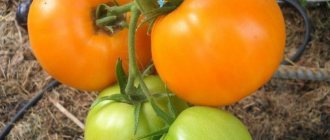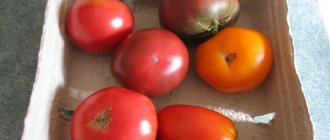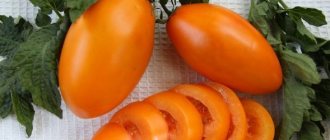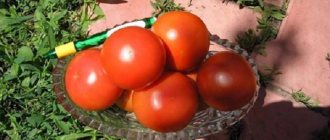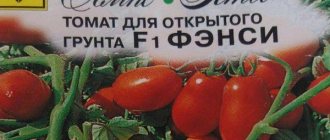There are 2 different plants known under the name Stone Flower tomato: a variety and an F1 hybrid. Our review is devoted to a hybrid variety, a new breeding creation. Today, among miniature cherry hybrids, it is the leader in both taste and yield. Most of the determinant cherry hybrids are inferior in terms of yield, taste and appearance of tomatoes.
You can grow beautiful small tomato fruits in an apartment on a windowsill, in a flower bed, in a garden and in a vegetable bed!
Description
Hybrid Stone Flower is a dwarf form. Its height is only 35 - 40 cm. This allows the plant to be widely used even in indoor cultivation; a small and neat bush will become a real decoration for any balcony or loggia. Even on a windowsill in a flower pot, a baby tomato will feel comfortable. The shoot-forming ability of the crop is moderate, there are also few leaves, but due to their compactness the bushes look very lush. The leaf blade looks healthy, elastic, small in size, slightly corrugated, rich green in color, of the usual type. The inflorescence of the variety is simple or semi-complex; as a rule, it is the semi-complex raceme that completes the growth of the central stem. In simple infructescences, almost all ovaries develop; in semi-complex ones, without additional pollination, 2 - 4 flowers may fall off the raceme. Tomato fruit clusters are compact, dense, and well filled. The first appears above the 7th sheet. Depending on the place of cultivation, inflorescences are formed in larger or smaller quantities. So, in open ground or protected, from 6 to 8 shoots develop on a bush (and with good care and warm weather, up to 20 shoots), on which, depending on the type of brush, 8 - 11 fruits or 18 - 25 will be formed. At home, the plant will show more modest capabilities - 2 - 3, sometimes 4 stems, on which a total of 6 - 10 inflorescences will develop. Each brush of the Stone Flower will have from 6 to 8 ovaries.
Various conditions also influence the formation of fruits. In the comfort of home, tomatoes are more even and have a perfectly round shape. Street fruits are slightly compressed on both sides. Unripe tomatoes are light green, there is no dark spot near the stalk. When fully ripe, the tomato takes on a rich, thick red color. The pulp of the tiny vegetable is very fleshy, juicy, yet dense and aromatic. There are 2 seed chambers, very few seeds. The taste of the variety is excellent. The taste is sweet, without sourness. The weight of homemade cherry tomatoes is about 10 grams; the size of street tomatoes is noticeably larger, and they weigh more than 12 grams.
Planting a plant
After the first flowering of the plant, it is necessary to carefully form the bushes. It is extremely necessary to do this because if the plant is given free rein, then it will direct all its forces exclusively to feeding the green leaves, and not to the growth and strengthening of the fruits.
The tomato variety “Stone Flower” produces more and more new shoots throughout the entire growing process. Those on the side are especially actively developing, and it is they who need to pay more attention. To get a good harvest, you need to use pinching.
It is recommended to adhere to the following rules:
- If the plant is grown in central Russia, then the shoots, as a rule, actively begin to grow around mid-summer, but they do not have time to properly form and ripen. For this reason, it is recommended to simply cut off the excess lateral processes. In addition, experienced gardeners recommend pinching those places where side shoots grow most actively, so that the plant does not waste nutrition and strength on their growth.
- When growing a plant in the conditions of central Russia, it is necessary to leave several stems on one bush. If the gardener plans to leave one stem in each bush, then it is best to plant the “Stone Flower” tomato sprouts as closely as possible to each other.
This unusual variety is liked by many lovers of this tasty vegetable. Its cultivation does not require too much labor and time. Due to the ease of caring for the plant, even a novice gardener who does not yet have experience in this matter can grow this variety of tomatoes.
Characteristics
- Hybrid Stone Flower is an early ripening crop. From the moment of the appearance of full shoots to the start of fruiting, only 80 - 85 days pass. At home and with proper agricultural technology, even earlier - 70 - 75 days;
- The productivity of the dwarf plant is very high. Dense planting will provide an almost 10-kilogram harvest. At home, of course, the yield is somewhat lower, but the whole family will be able to enjoy delicious tomatoes to their heart’s content;
- the yield of the harvest is very friendly, the fruits ripen quickly, so in 2, maximum 3 harvests you can harvest the entire harvest;
- ripe tomatoes can hold tightly in the hands for almost 3 weeks without falling off;
- strong, but not thick, glossy skin prevents cracking;
- The immunity of the variety is very strong. It is for its ability to resist diseases that the baby received its name. The culture is resistant to tobacco mosaic virus, verticillium, root and basal rot. Thanks to early ripening and friendly yield, late blight does not have time to infect the bushes;
- the transportability and shelf life of the Stone Flower fruits are good;
- method of use is universal. Children and adults enjoy eating sweet tomatoes straight from the bush. Tomatoes are used in salads, to decorate cold dishes and vegetable smoothies. The thick skin can withstand heat treatment, so tomatoes can also be used for whole-fruit canning.
Pros and cons of tomato
The main advantages of the Stone Flower F1 tomato include:
- early fruit ripening;
- high yield for cherry tomatoes;
- pleasant taste of ripe tomatoes;
- compactness of bushes;
- resistance to most diseases characteristic of other tomato varieties;
- versatility of the harvested crop;
- friendly ripening of fruits;
- ripe tomatoes can hang on the bushes for a long time without falling off;
- the possibility of growing tomatoes at home;
- The harvested crop tolerates transportation well and can be stored for quite a long time.
Cherry tomatoes: description with photos of the best varieties for the greenhouse
This hybrid has virtually no disadvantages
. But you need to remember that the seeds of this hybrid have to be purchased annually in the appropriate stores. In addition, not all vegetable growers like to grow small tomatoes in their garden.
Agricultural technology
It should be noted right away that direct sowing of seeds is not profitable; for a good result, you first need to grow seedlings. Calculate the timing yourself, taking into account climatic conditions and the ability to grow the hybrid in an extended rotation. The recommended planting density is high - 6 - 7 seedlings per 1 square meter. On a balcony or in a room, the variety grows well and bears fruit with sufficient lighting; with additional lighting, you can get a harvest even in winter. When growing at home, the variety will not require much space; a 5-liter container and universal soil will do. By the way, do not forget to put a layer of drainage on the bottom of the pot, 3 - 4 centimeters. The stocky bush of the Stone Flower does not need to be tied up, but if a lot of fruits are set, that’s all It’s better to put a support. The tomato forms itself, so it does not need pinching. The house plant has a peculiarity. By the end of the fruiting period, up to 5 - 7 stepsons may appear in the lower part of the bush from leaf scars. You can get an additional harvest from the strongest ones by cutting off the top part of the bush above them. By the way, the decorative appearance of the plant will quickly be restored; the overgrown stepsons will quickly hide the cut.
Care is no different from standard. In indoor conditions, the species is cared for as for balcony cherry varieties, outdoors - as for determinate varieties. You can find out more about how to grow tomatoes on a windowsill in one of our articles.
The hybrid Stone Flower is a new word in breeding, because the qualities inherent in it, our hero is much superior to previously known varieties. The plant can be grown in any conditions, the yield is very good, and everyone likes the taste. Children especially like the tiny fruits. The species is very unpretentious in care, so children can safely be entrusted with watering a tiny tomato growing on the windowsill. What a pleasure it is to watch him grow! In open ground, the variety can be planted not only in a garden bed; strong bushes can be used as a living decorative border. But the seeds will have to be purchased annually, since the second generation hybrids will not please with such excellent quality.
Tips for Growing Stone Flower Tomato
The agricultural technology of the “Stone Flower” tomato is slightly different from other varieties. The main difference is that tomatoes can be grown at home. Therefore, planting seeds for seedlings depends on where the bush will live.
Tomatoes do not require a lot of fertilizers and frequent watering, they do not need to be pinched, and they need minimal support so that the bush does not break.
When to sow stone flower tomato seedlings
Growing for seedlings is done in late March-early April, if the bushes will grow outside the house.
If you plan to grow a tomato at home, then the date of planting the seeds for seedlings does not matter. Tomatoes can ripen all year round, only in winter they require additional lighting.
Otherwise, sowing seeds and caring for seedlings follows the usual pattern.
- The seeds are soaked and disinfected in a weak solution of potassium permanganate. The prepared soil is laid out in wide, shallow boxes and well soaked with water.
- Make grooves 1.5 cm deep.
- Plant the seeds and cover them with a layer of soil.
- Sprinkle with water again and cover with cling film.
The “Stone Flower” variety requires additional lighting, so they are illuminated with phytolamps.
How many days does it take for stone flower tomato seeds to sprout?
After 7 days, you can see the sprouts appearing. After this, the film is removed. Sprouts require regular watering. To avoid washing out the roots, water them with a spray bottle. It is necessary to apply liquid fertilizer to the seedlings a couple of times.
With the appearance of two or three strong leaves, the seedlings are picked. To grow in greenhouses or greenhouses, the sprouts are transplanted into individual cups. To use tomatoes as indoor plants, seedlings are planted in 5-8 liter wide pots. Any universal soil is suitable for growing the plant. Drainage is placed at the bottom of the container.
“Street” seedlings should be hardened off before planting in the ground. To do this, 7-10 days before transplantation, it is taken outside. First, the pots are exposed to air for a short period of time, then the time is increased.
When and at what distance to plant in the ground
The hybrid is planted in the ground when warm weather sets in and the thermometer does not drop below 16℃. This usually happens in the second half of May. 7 bushes are planted per 1 m².
The soil for planting is prepared in advance: it is dug up, fertilizers are applied, old roots and weeds are removed.
Ammonium nitrate is poured into the prepared holes to stimulate growth, the plant is lowered and generously watered with water at room temperature.
Ripening time
“Stone Flower” is an ultra-early tomato. At home, it ripens in 70-75 days; in a greenhouse and in garden beds, the fruits are harvested 80-85 days after sowing the seeds.
At home, a tomato can bear fruit all year round, the main thing is to provide it with sufficient lighting.
Watering
After the bushes have been transplanted into the ground and watered, the next watering should be after 7 days.
Subsequently, the plant is watered as the top layer dries out. This usually happens within 2-3 days. Water is poured strictly at the root, trying not to get on the leaves. The water should not be cold. Do not water during daylight hours.
What and when to feed
In addition to applying fertilizer when planting in the ground, the plant must be fed at least twice:
- when they bloom, add potassium sulfate;
- Before fruiting, fertilize with superphosphate.
In addition, tomatoes require weeding, loosening the soil, and inspection for pests.
Should I dive?
They dive the plant when planting it from the container. Indoor plants when transplanted into pots, and outdoor plants when transplanted into individual cups.
The dwarf bushes of the “Stone Flower” do not need to remove the stepsons. The bush is formed into two trunks. They need to be tied so that they do not break under the weight of the fruit.
House bushes can produce two crops per season. After harvesting the first harvest, they throw out several stepsons from below. If you cut off the top of the strongest ones, they will produce a new portion of tomatoes. The cut will not be visible; it will be covered by regrown shoots.
Pest Control
It was not for nothing that the variety was called “Stone Flower”; it is completely insensitive to many diseases characteristic of tomatoes. Regular spraying with folk remedies and inspection for pests will protect against pests: wireworms, moths, snails and slugs.
Description
The plant is of a determinate type, the shape of the bush is standard, the height is about 50 cm (according to other sources, about 70 cm). The foliage is medium, the leaves are small, of the usual type, green, slightly wrinkled. Each fruit cluster ripens 4-5 round or flat-round fruits. The color at the stage of consumer ripeness is bright red. The pulp is fleshy, dense and aromatic. But, according to reviews from vegetable growers who grew this tomato, there are often voids inside in the area of the seed chambers. The taste is ordinary, some describe it as tasteless, the flesh is too hard, dry and crumbly. The weight of the Stone Flower fruit is 150 - 300 grams, but 400 and sometimes 600 gram specimens are often mentioned. The description of the variety says that 16 - 20 tomatoes are harvested from one plant. According to other information, in 2017 the variety was among the 10 most productive, therefore it is recommended for small farmers growing vegetables for sale.
Brief information about the variety
- Fruits and bush : deep red tomatoes, average weight - 250 g. Indeterminate bushes can reach a height of 150 cm.
- Productivity : per bush – 10-12 kg of tomatoes.
- Resistance : low frost and drought resistance. Disease resistance is average.
- Distribution : Ural, Caucasus, Siberia and Moscow region.
- Application : various dishes, sauces and tomato paste.
- Planting : seedling method. The optimal time for planting is April-May. Scheme – 50×50.
- Soil : loose and nutritious.
- Care : soil irrigation, loosening, weed removal and fertilizing. Mulching and pruning as needed.
- Ripening period : early variety - the fruits ripen 60 days after transplanting the plants to a permanent place. Tomatoes are suitable for long-term storage.
Characteristics
According to the ripening period, varietal tomato is classified as mid-ripening, and sometimes late-ripening if weather conditions are disappointing. About 110 days pass from the appearance of full shoots to the start of ripening. There is no exact information about the yield of the Stone Flower, but the description states that the variety is very productive. Tomato growers also confirm this characteristic. The plant is very resistant to various fungal and viral diseases. The thick skin protects the tomatoes from cracking. The harvest can be transported over long distances without fear of loss of presentation. In terms of shelf life, we can say that the variety is considered one of the most shelf-stable and is suitable for long-term storage. The method of consuming fruits is universal. In addition to being used in its natural form, tomatoes are suitable for all types of processing.
Pests and diseases
Tomatoes were called stone flowers not only because of their beautiful clusters with red fruits. During the years of testing before launching for sale, tomato bushes were never exposed to any diseases due to good health and excellent immunity.
When grown in a greenhouse or in a garden, it is recommended to treat the bushes once with a fungicidal solution 2-3 days after transplanting.
To combat Colorado potato beetles, aphids, and spider mites, folk remedies or insecticides are used.
After treating the plants with chemicals, the fruits are harvested no earlier than 7 days have passed.
Larisa Nikolaevna Shirko
A gardener with extensive experience ready to answer the most difficult questions
Ask a Question
The tomato variety Stone Flower is suitable for growing in an apartment, under a film cover, in a greenhouse or on a street ridge. The tomato hybrid is quite productive, the tomatoes are tasty, shelf-stable and have universal use. No critical disadvantages were found. Care is standard, when growing at home - as for balcony varieties of cherry tomatoes. And in the beds - like behind determinate plants. A prerequisite for a good harvest is compliance with the rules of agricultural technology.
Agricultural technology
It is advisable to grow this Stone flower in open ground, but it can also be grown in a greenhouse. Seedlings that are 60-65 days old are transplanted into the ground. Although the tomato belongs to the standard variety, experienced tomato growers recommend tying it to a support, but pinching is not required. It is recommended to plant up to 6 seedlings per 1 square meter of area. The variety is very unpretentious in care. The main thing is, try not to skip watering and fertilizing. Also, do not neglect loosening and weeding.
The stone flower is not as well known as the hybrid of the same name. But many consider it an indispensable crop in the garden, which gives a good harvest of universal use. Unpretentious, with good health, this species is perfect for busy tomato growers. Another advantage of this tomato is the ability to collect seeds yourself.
Sowing time for seedlings
When to plant Stone Flower tomato seedlings? Before sowing seeds, you need to decide on the location where the crop will grow. There are no standardized sowing dates for cultivation under indoor conditions. A tomato seedling grows safely and bears fruit in warmth and under normal lighting.
For transplanting into greenhouses or outdoor beds, it is better to sow at the end of March - early April.
We offer favorable dates for sowing tomato seeds in 2022 so that you can calculate your sowing numbers.
Table 1.2 - Lunar sowing calendar for obtaining tomato seedlings for 2022
| Month | Favorable dates | Unfavorable dates |
| February | 4 – 9, 12 – 14 | 1 – 3, 15, 16, 28 |
| March | 5 – 8, 11 – 13 | 2 – 4, 14, 15, 18, 27, 28 |
| April | 4, 8, 9, 13, 14 | 1 – 3, 16, 30, 10 – 12, 23 – 25 |
If the purchased Stone Flower seeds are not in a protective shell, then they are subject to pre-sowing treatment. They are soaked in warm water, and then treated with a pinkish solution of potassium permanganate or dipped in a Fitosporin solution for 1 hour.
Care
Although Campanula is unpretentious, planting and care are fraught with many pitfalls. To get lush inflorescences, follow simple care tips.
- Place. Terry campanula, like other varieties, takes root well on balconies and verandas in the warm season. Indoors, it is better to place the plant in places facing west and east, for example, in an opening between windows or in a hanging pot.
- Lighting. Campanula does not like direct sunlight: the light should be diffused. However, this flower does not survive in dark places; the stems lose their decorative effect, becoming long, and the spaces between the leaves increase. The campanula has one peculiarity - it stretches towards the light source. It cannot be rotated 180 degrees. If there is not enough lighting in the room, make turns gradually.
- Temperature. The flower prefers cool conditions, so a living room or bedroom (but not the kitchen!) would be a great place for it. It is better to place the plant away from the window: campanula does not like direct drafts. In the warm season, the optimal temperature will be 22-23 degrees, in winter – 12-15 degrees.
- Watering and humidity. During the growing season and in dry conditions, the plant should be watered daily with warm water. In winter, spraying will be sufficient.
- Fertilizers. It is better not to experiment with them during the planting period. Further, when the plants take root, any mineral fertilizer or organic matter will do.
- Hygiene. In autumn and spring, campanula needs to be pruned - remove dried, too thin or fattening stems. This event will provide excellent material for propagation and replanting. It is recommended to renew the soil once a year, since the strong roots of Campanula quickly deplete the soil. You can't do without updating the flower itself. To do this, it is enough to regularly plant cuttings and remove old ones. Campanula leaves must be sprayed or wiped from dust. Clean foliage is the key to lush flowering.
- Wintering. In autumn, the growth of Campanula slows down. At this time, trim too long stems, remove dried inflorescences and put the plant in a cool place. Before doing this, it is recommended to lubricate the cut areas with a disinfectant or crushed coal. Watering in winter is very rare, but do not forget about daily spraying. Heating in houses and apartments creates a dry microclimate, and the soil near the campanula should always remain moist. When spring comes, the plant needs to be trimmed again and moved to a warm place.
- Diseases. Campanula may be susceptible to spider mites or scale insects. In this case, the plant is treated with insect repellents. Another enemy of the beauty is gray rot, which occurs due to excess moisture and excessive watering.
Transplanting seedlings
It is better to transplant seedlings into a greenhouse in mid-May. In open ground - in early June.
- Choose a site with light nutritious soils.
- Level the ground and mark it.
- Planting pattern – 50x50 cm.
- The depth of the hole is 20 cm.
- Seedlings are placed in the hole and covered with soil.
- Water with 1 liter of warm water.
If there is a risk of cold weather after transplanting, cover the beds with film overnight. During the day, remove the shelter so that the root system does not begin to rot.
Plant productivity depends on proper care
Without watering, fertilizing, forming bushes and removing weeds, you will not be able to harvest at the end of the season. In greenhouse conditions, water the beds every week, using 5 liters of water for each bush. In open ground, the frequency of watering depends on weather conditions. On hot days, water 2 times a week, on cool days - once every 7-10 days. Water consumption is at least 5-7 liters per bush.
After irrigation, weeds are removed, which provoke the development of bacteria leading to diseases and pests. Loosening is carried out 2 times a week to avoid the formation of a crust on the surface of the soil, otherwise it will not allow air to penetrate into the root system, and the crop will die.
Tomatoes will not die from crusting on the surface of the soil, but they will feel depressed.
Based on the characteristics of the agricultural technology of the Stone Flower variety, fertilizers must be applied according to a certain scheme:
- 2 weeks after transplantation, water each bush with a solution of saltpeter (300 g per 10 liters of water);
- at the end of June, during flowering, fertilize with potassium fertilizer (50 g of potassium sulfate per 5 l);
- in August, a week before harvesting, irrigate the tomatoes with a superphosphate solution (100 g per 5 l). This volume is enough for 2 plants.
According to the characteristics, the formation of a bush with 2 stems helps to increase the productivity of the variety. In June, you need to remove all shoots located below the 3rd pair of leaves. They cut off the stepsons that thicken it.
High-quality care for tomatoes should include the fight against diseases and pests. To protect plants from powdery mildew, use “Topaz” (20 g per 5 liters of liquid). “Oxychom” (70 g per 10 liters of water) is effective against late blight.
“Regent” (4 g per 6 l) can scare away the codling moth. Destroy the wireworm - bazudin. To save bushes from slugs and snails, use ammonia (10 ml per 10 l). Use “Karate” (3 ml g per 5 l) against the Colorado potato beetle. Spray the beds at intervals of 14 days.
Landing
How to sow seeds and care for seedlings:
- use fertile nutrient soil;
- pre-moisturize;
- make grooves at a distance of 4-5 cm;
- sow 2 cm deep;
- keep under film until germination;
- illuminated with phytolamps (16-hour daylight hours);
- temperature regime 24-25 degrees before germination, then 20-22 degrees.
At the stage of 2-3 leaves, they are picked into pots or cups. Fertilize 2 times, use Agricola solution or nitroammophoska.
Seedling bushes are ready for transplanting upon reaching 52-55 days. Hardening is carried out in advance for 10-12 days.
Planting seedlings in open ground
It is necessary to plant tomatoes of the Stone Heart variety in open ground or a greenhouse in early June. Because at this time there are no longer night frosts and warm temperatures set in.
On the territory of the plot, tomatoes are arranged in rows; an interval of up to 40 cm is maintained between holes, and up to 50 cm between rows.
Before planting tomato seedlings, you need to make shallow holes in the area and thoroughly water them with warm water at the rate of 1 liter per hole.
Note! If the cultivation of tomatoes of the Stone Heart variety is carried out using purchased seedlings, it is advisable to purchase them on the day of planting. This will prevent it from withering and developing diseases.
It is necessary to transplant tomato plants into the soil almost until the middle of its growth.
Many gardeners and summer residents even recommend tearing off a few bottom leaves from the plant. After the hole, fill it with dry soil and water the plants.
It is necessary to transplant tomato plants into the soil almost until the middle of its growth. Many gardeners and summer residents even recommend tearing off a few bottom leaves from the plant. After the hole, fill it with dry soil and water the plants.
